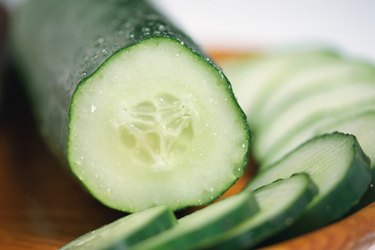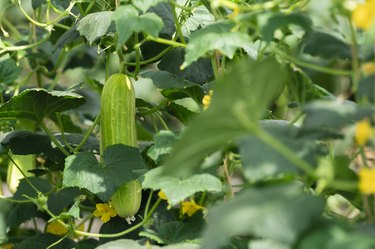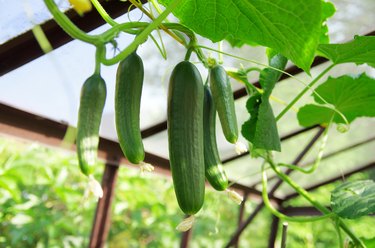
Cucumbers are versatile in the kitchen and easy to grow in the garden, making them one of the most popular of all vegetables for home gardeners in the United States. Despite their popularity, however, cucumbers are susceptible to several pests and diseases that can take most or all of your cucumber crop. If your cucumber leaves are drying out and browning, identifying the cause -- it's a shared symptom of several common problems -- will help you correct the current problem and prevent it in the future.
Cucumber Leaves Drying Out from Aphids
Video of the Day
Aphids -- also called plant lice -- gather in multitudes on the undersides of cucumber leaves, where they suck sap from the plant. Although tiny, the combined action of thousands of aphids can drain the plant of water and nourishment, resulting in the cucumber leaves drying out and turning brown. When aphids attack, you may also notice the leaves becoming twisted and deformed.
Video of the Day
Beneficial insects like wasps and ladybugs naturally keep aphid populations in check. If you find yourself with an infestation, however, spraying the plant with insecticidal soap may save it. Spray the entire plant, including under the leaves and other places where aphids hide, as the soap must come into contact with the aphid in order to work.
Damage From Squash Bugs
Another sap-sucking cucumber pest is the squash bug. These pests resemble brown stinkbugs in their adult form, but you're most likely to spot the eggs or nymphs. They also drain the plant of sap, causing leaves to wilt and die. If you see your cucumber leaves turning brown, look for clusters of copper-colored eggs or groups of blue-gray nymphs on the undersides of leaves and stems.

Once squash bugs infest your plant, they are hard to control. Destroy any adults, nymphs or egg clusters that you find. A board placed beneath the plant can serve as a hiding place for the bug, making them easy to monitor and kill. Once cucumbers begin forming vines, you should check them regularly for squash bugs.
Browning Leaves From Bacterial Wilt
Bacterial wilt is spread by another common cucumber pest, the cucumber beetle. These small beetles are boldly patterned with stripes or spots and feed on all parts of the cucumber plant, transmitting bacterial wilt in the process. Infected plants begin to wilt and turn brown, often beginning with a few vines, then spreading to the entire plant. Unfortunately, there is no treatment for bacterial wilt.
To prevent bacterial wilt, control the cucumber beetle. Insecticides can destroy this pest, although you'll have to take care not to harm pollinating honeybees. Floating row covers prevent the beetle from accessing your plants; however, you'll need to remove these to allow for pollination.
Browning From Gummy Stem Blight

This fungal disease begins with brown blotches on the leaves of your cucumber plant. As it progresses, the entire leaf can turn brown. You may also observe stem splitting and brown secretions from the wounds, as well as lesions on cucumber fruits. Gummy stem blight can kill part or all of your plant.
Good garden sanitation and crop rotation practices help prevent gummy stem blight. Remove all dead plant material from the garden and avoid planting cucumbers in the same place in the garden for multiple years in a row. If gummy stem blight proves a persistent problem in your garden, you can apply preventive fungicides.